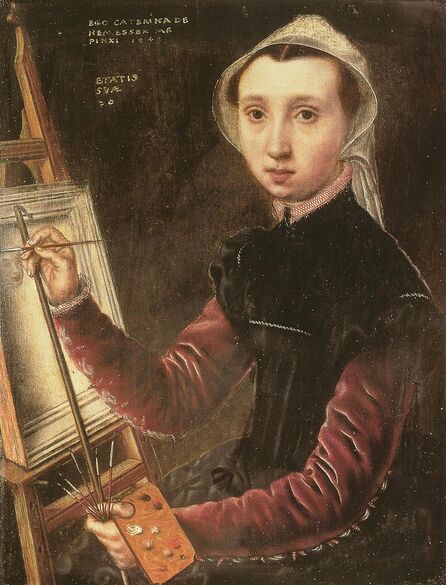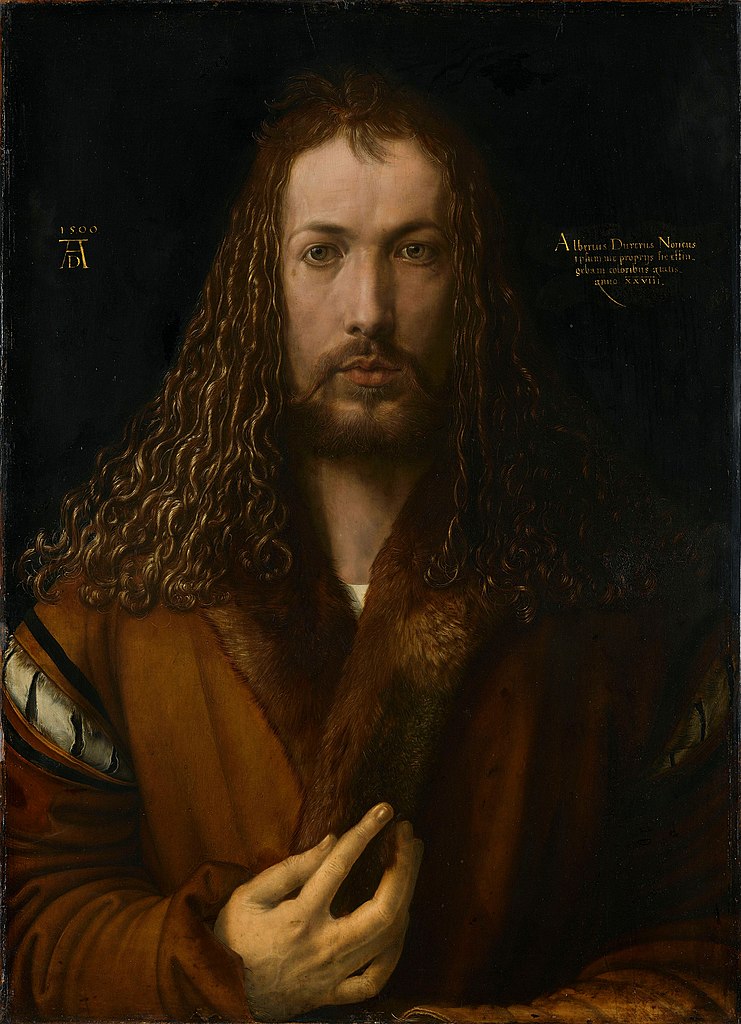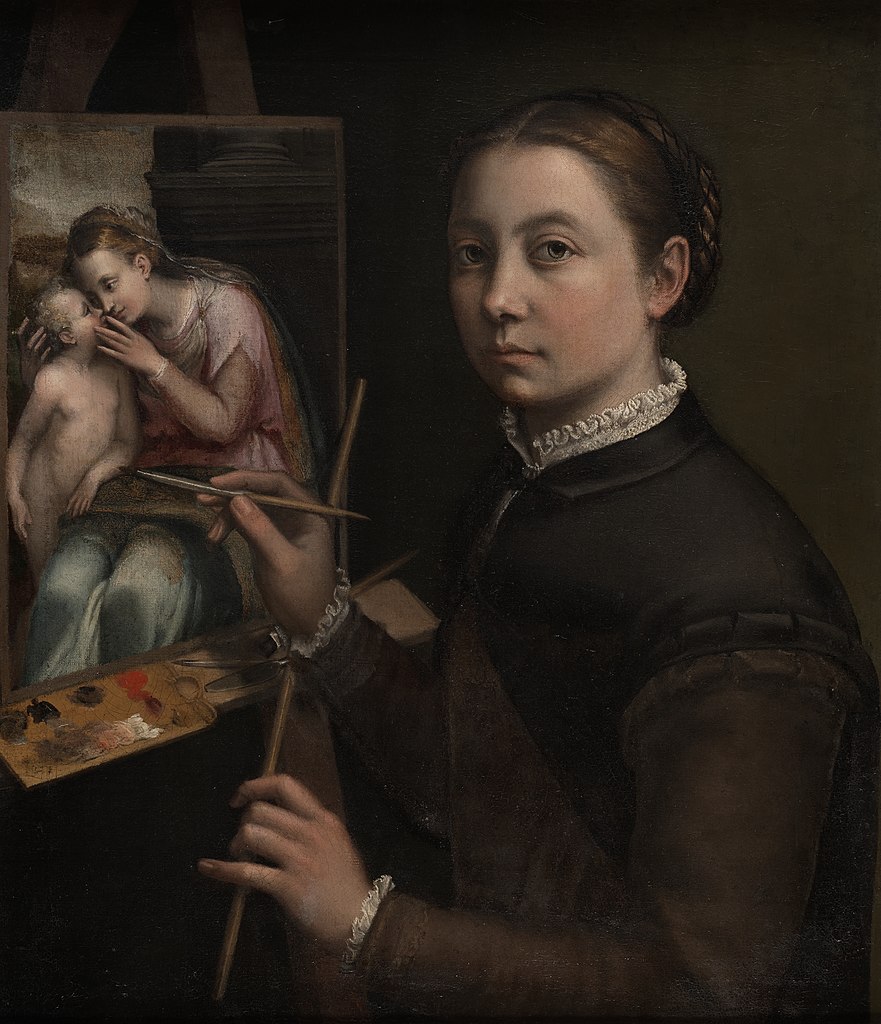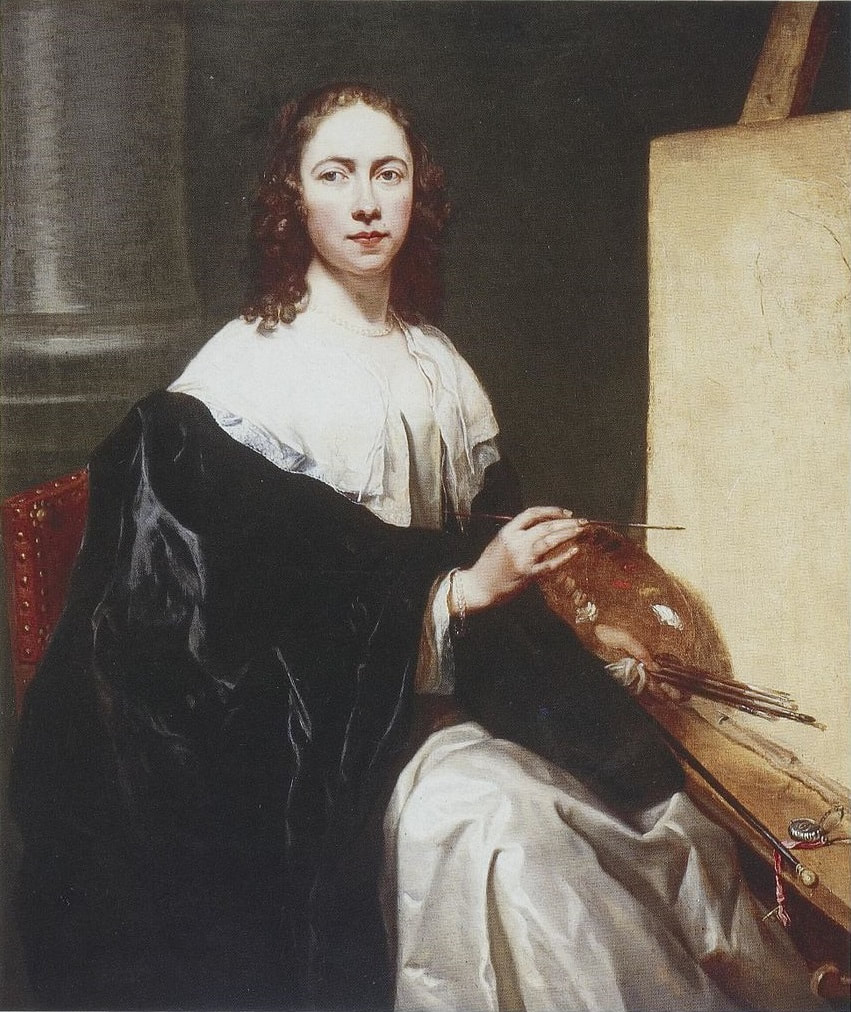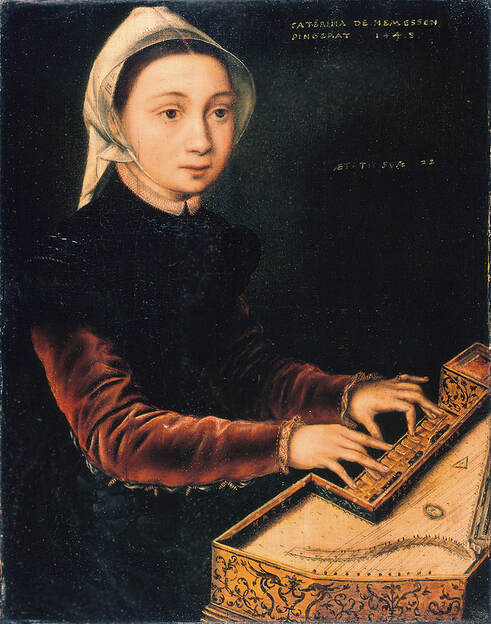|
Where? Kunstmuseum Basel
When? 1548 What do you see? A self portrait of the 20-years old Caterina (also spelled Catharina) van Hemessen. It shows the artist at her easel, working on the outline of a face. She probably looks into a mirror, not at the viewer. She wears the traditional wired head cover (haube) made of fine linen or perhaps delicate cotton that confirms she is at work or may refer to her devoutness. She holds her brushes and palette with the ease and familiarity of an artist. The brushed velvet of her clothing is expensive and proclaims her status and wealth in society. The white of the oak panel on the easel draws attention to the beginning of her drawing. The portrait of herself seems to be a bit out of proportion, with her head and arms appearing relatively larger than what her body suggests. Note also the cross created by her brush in her right hand and the maulstick (rest or steadying stick used when painting) in her left. Perhaps she is equating her painting ability to a gift from God that she is sharing. Van Hemessen has reversed the drawing on the panel from what the viewer sees in the finished portrait to provide a triangle from the unseen mirror, to the brush, to her face. She signed her finished painting: "Ego Caterina de Hemessen me pinxi 1548; Etatis suae 20" which translates to; I, Caterina of the Hemessens, painted me in 1548 at the age of 20. She wanted to be remembered. Backstory: It is one of the oldest self-portraits painted by a woman, but more importantly, she has painted herself seated at the easel. Albrecht Dürer (1471–1528), who died the year Caterina van Hemessen was probably born, painted several portraits of himself and is recognized as an early exponent of the self-portrait genre. Dürer never represented any of the paintbrushes, palette, easel, or even an allusion to his craft. Caterina not only makes it clear that she is a painter, she conveys that she is educated, wealthy, and suggests her religious nature. Caterina's contribution to and development of self-portraiture can be seen in the following years as several of her fellow female artists also eternalized themselves at the easel, including Sofonisba Anguissola (1532–1625), Artemisia Gentileschi (1593–c.1653), Michaelina Wautier (1604–1689), and Judith Leyster (1609–1660).
Other versions: Three almost-identical versions of this self-portrait exist. The current version is in the Kunstmuseum in Basel. Another is in the Hermitage Museum in Saint Petersburg, and one is in the Michaelis Collection in Capetown, South Africa. The self-portrait is likely a pendant to Girl at the Virginal. Both paintings were created in the same year. They are similar in size, and it is believed that the girl at the virginal is Christina, Caterina's elder sister (though some scholars believe it is another self-portrait.)
Who is Van Hemessen? Caterina van Hemessen (c. 1528 – c. 1588) was born in Antwerp, the second of two daughters. The city was one of the leading art centers of Europe at the time. She would have been a contemporary of Pieter Bruegel the Elder and Frans Floris. Her father, Jan Sanders van Hemessen (1500–1566), was a Flemish Renaissance painter who is considered the inventor of Flemish genre paintings (the portrayal of people engaged in everyday activities). He had been to France and Italy in the 1520s and must have been affected by all that he learned while there. It is assumed that he taught his daughter to paint, and his influence may have been the reason she felt she could paint herself and reveal what she was capable of doing with paint and brushes. Caterina collaborated with her father on some of his paintings, and she herself specialized in portraits of wealthy men and women. She also produced religious art, and there are nine portraits and four religious works attributed to her today.
The majority of her portraits are realistically painted against a neutral or dark background, as was the custom. Her focus was to capture their facial features without reference to surroundings in time or space, and each was small in size, on average, 30 x 20 cm. Following in her father's footsteps, she became a member of the Guild of St. Luke and had three male students of her own. In 1555, she is recorded as a maid of honor in the official lists of the Brussels Court of Mary of Hungary. Giorgio Vasari included her in his book Lives of the Most Excellent Painters, Sculptors, and Architects (1568) with the Flemish painters. Fun fact: Caterina married Christian de Morien in 1554 when she was 26 years old. He was the organist for the Antwerp Cathedral. Two years later, they were invited by Queen Mary of Hungary, regent of the Low Countries, to join her court after returning to Spain. Queen Mary died in Spain two years later but had granted the couple a pension for life. They returned to Antwerp and were able to live comfortably for the rest of their lives. Only two paintings from after her marriage are attributed to Van Hemessen, the last one dated 1560, indicating that she had largely given up on her career as a painter. Few records about her life are found after 1567.
Written by Carol Morse and Eelco Kappe
References:
2 Comments
Glenda Dohrn
10/22/2022 11:08:26 am
Beautiful thoughtful portraits
Reply
Judith Hughes
10/23/2022 12:05:12 am
Interesting to learn about early women artists.
Reply
Leave a Reply. |
Categories
All
|
- Home
- Blog
-
Museums
- Alte Pinakothek
- Art Institute of Chicago
- Baltimore Museum of Art
- Barber Institute of Fine Arts
- Bargello
- Barnes Foundation
- British Museum
- Church of Sant’Anastasia
- Cleveland Museum of Art
- Courtauld Institute of Art
- Detroit Institute of Arts
- Frans Hals Museum
- Galleria Borghese
- Gallerie dell'Accademia
- Getty Museum
- Guggenheim
- Hermitage Museum
- Kunsthistorisches Museum
- Kunstmuseum Basel
- Legion of Honor Museum
- Louvre
- Mauritshuis
- Metropolitan Museum of Art
- Musee d’Orsay
- Museum of Fine Arts in Boston
- Museum of Modern Art
- National Gallery in London
- National Gallery of Art
- National Museum in Poznań
- Norton Simon Museum
- Ny Carlsberg Glyptotek
- Palace of Versailles
- Palazzo Pitti
- Palazzo Vecchio
- Petit Palais
- Philadelphia Museum of Art
- Prado
- Pushkin Museum
- Ravenna Art Museum
- Rijksmuseum
- San Diego Museum of Art
- Santa Maria delle Grazie
- St. Peter's Basilica
- Städel Museum
- Statens Museum for Kunst
- Tate Britain
- Tate Modern
- Timken Museum of Art
- Uffizi
- Vatican Museums
- Wallace Collection
-
Artists
- Altdorfer
- Anguissola
- Berlin Painter
- Bosch
- Botticelli
- Boucher
- Bronzino
- Bruegel the Elder
- Brunelleschi
- Cabanel
- Caillebotte
- Canova
- Caravaggio
- Carpeaux
- Cezanne
- Cimabue
- David
- Degas
- Delacroix
- De Maria
- Donatello
- El Greco
- Fontana
- Fra Angelico
- Fragonard
- Gauguin
- Gentileschi
- Gericault
- Gonzalez-Torres
- Goya
- Hals
- Hogarth
- Hokusai
- Ingres
- Leonardo da Vinci
- Lippi, Filippo
- Longhi, Barbara
- Lorrain
- Makovsky
- Manet
- Massys
- Matisse
- Merian
- Michelangelo
- Mochi
- Modigliani
- Monet
- Panini
- Parmigianino
- Perugino
- Picasso
- Pisanello
- Raphael
- Rembrandt
- Renoir
- Reynolds
- Rivera
- Rodin
- Rubens
- Scultori
- Seurat
- Steen
- Tintoretto
- Titian
- Toulouse-Lautrec
- Turner
- Uccello
- Van der Weyden
- Van Dyck
- Van Eyck
- Van Gogh
- Van Hemessen
- Vasari
- Velazquez
- Vermeer
- Veronese
- Vigée Le Brun
-
Locations
- Books
- About Us

